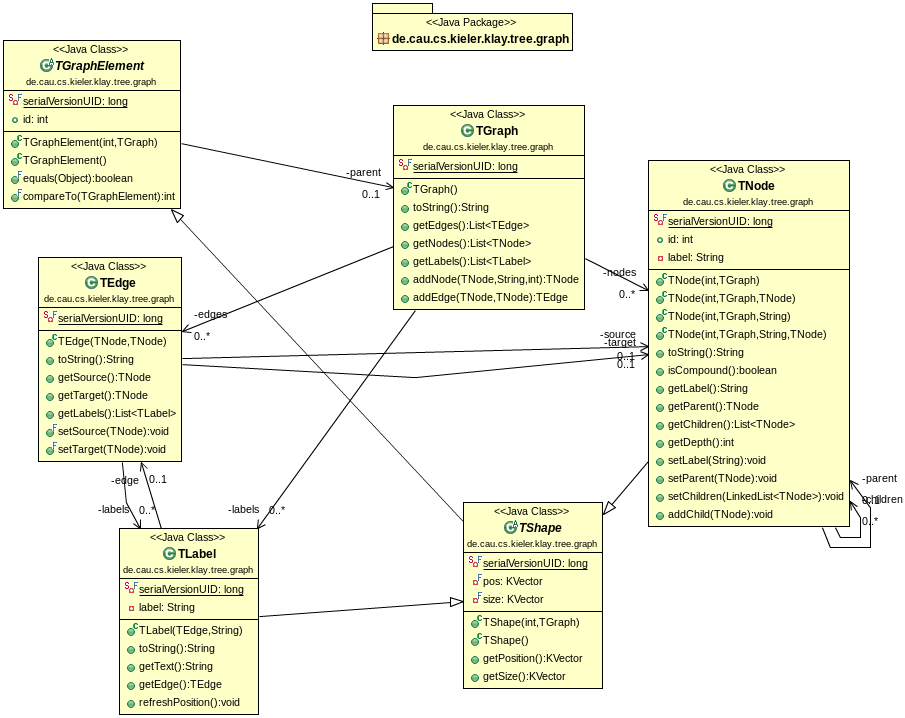Mr. Tree Layout Algorithm
This project is all about developing a tree layout algorithm. We pity the fool who doesn't use Mr. Tree Layout!
This page will over time be filled with documentation written by the project team. But first, here's some general information to get you started:
| Project Team |
|
| Project Goals | The following are our main goals for this project:
|
| Plug-in Name | de.cau.cs.kieler.klay.tree |
| Repository | KIELER Pragmatics |
| Branches |
|
Page Contents
Schedule
Some Ideas...
Use this section to keep a schedule of milestones that you want to achieve, together with deadlines. This will help you to get work done on time, and it will help us to keep an overview of your project's status.
| Deadline | Milestone |
|---|---|
2013-05-02 2013-05-10 | Review tree layout methods and make a first decision on which ones are to be implemented. Presentation in weekly meeting. Create and implement the start of the MrTGraph data structure. Presentation in weekly meeting. |
Literature
Related publications:
- J. Q. Walker, II. 1990. A node-positioning algorithm for general trees. Softw. Pract. Exper. 20, 7 (July 1990), http://www.cs.unc.edu/techreports/89-034.pdf
Architecture
Some Ideas...
You will have to think about how you are going to implement your algorithm. One possible architecture is to divide the work of the algorithm into sub-algorithms, called phases. This makes it easy to provide different implementations of phases that result in different kinds of tree layouts. KLay Layered uses this approach. You can find some documentation about this approach on its Confluence page. Further information can be found in a paper we just wrote, but haven't published yet. If you are interested in reading it, feel free to ask for a copy of the paper.
Remember: This will probably not be the only possibility for structuring your algorithm.
Also remember: What starts with a first small and simple implementation will grow into a much more complex algorithm, with possibilities for customizing the result and different kinds of layouts that are computed. Design your architecture with this kind of complexity in mind. Feel free to talk to us once you've settled on an architecture.
MrTGraph Data Structure
The MrTGraph data structure is best explained by looking at the following diagram:
The basic data structure constis of the three classes TNode, TGraph and TEdge, which contain all the necessary properties to model a tree data structure. Therefore a TGraph consits of sets of TEdges and TNodes.
The TNodes are objects of the type TShape. That means that a nodes' size and position is defined by the attributes defined in the class TShape. The class TShape is an abstract superclass for the class TGraphElement. So the class TGrahpElement provides the utilites to declare any generic graph element of which a TGraph consits of.
Since an input KGraph is transformed into a TGraph, so that our algorithms can work on that TGraph, we do want to have the opportunity to set specific properties on graph elements. That is what the class TGraphElement is for. This specific way of implementation allows us not to model every property itself, but to model a class which can set an abritrary amount of properties on the graphs' elements. This data structure provides all the needs to perform a transformation from a KGraph to a TGraph that is as easy and therefore as evident as possible.
Features
Some Ideas...
The bottom line is to develop an algorithm that lays out a graph in a tree layout. Here a some first ideas for further features you might look into.
- Support for connected components
- Different kinds of tree layouts (top-down tree, left-to-right tree, radial tree...)
- Support for node and edge labels
- Support for graphs with cycles
- Support for ports
- Layout options for customizing the algorithm
Feel free to think about further ways to enhance the algorithm. Make sure to set priorities and to properly divide responsibilities among the team members.
